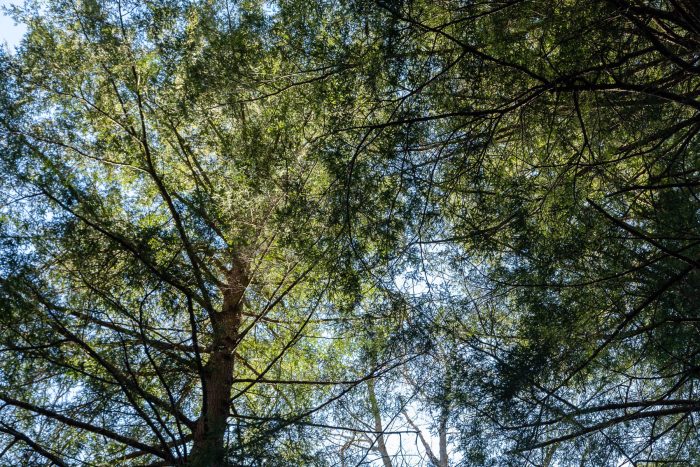Eastern Hemlock
Tsuga canadensis
Eastern hemlocks are important riparian trees that can live for centuries.
This section shows one large critter image at a time. Use the thumbnails that follow to select a specific image to display here.

This gallery contains a grid of small thumbnails. Selecting a thumbnail will change the main image in the preceding section.
Appearance
The eastern hemlock can grow to be close to 200 feet tall with a seven-foot diameter trunk. The hemlock tree is an evergreen that maintains its needles year-round. The quarter to half-inch flat needles are rounded at the end and green on top with white bands on the underside. Young trees have dark and smooth bark in comparison to the cinnamon brown, thick bark of older trees. The branches tend to point downwards.
Predators
The hemlock woolly adelgid is an invasive species that is decimating hemlock forests across the east coast. The pest was introduced in the mid-1900’s and researchers are still working to find the best way to control its spread.
White-tailed deer, porcupines, snowshoe hares, northern flickers, black-capped chickadees and American goldfinches feed on the bark, branch tips and seeds of hemlock trees.
Reproduction and life cycle
Hemlock trees need at least ten years to reach sexual maturity, some don’t produce seeds until they are 40 years old. Each tree produces both male and female flowers which are pollinated by the wind. The flowers appear in the spring, the cones ripen in the fall and release seeds in winter. Hemlock trees can grow to be more than 500 years old.
Did you know?
-
Hemlock bark is rich in tannins and was traditionally used in the tanning of hides.
-
A tea rich in Vitamin C can be made from the twig tips and inner bark.
-
The eastern hemlock is the state tree of Pennsylvania.
-
The name “hemlock” is believed to come from the smell of the leaves which is reminiscent of the smell of European poison hemlock.
-
The Limberlost area of Shenandoah National Park is known for its eastern hemlock trees. The legend about the trees is that George Freeman Pollock, a nearby landowner at the time, wanted to save the trees and paid $10 per tree for 100 trees to keep them from being cut down. Unfortunately, most of the trees in Shenandoah National Park have been destroyed by the hemlock woolly adelgid.
Sources and additional information
Shenandoah National Park - Eastern Hemlock
National Wildlife Federation - Eastern Hemlock Forests
New York State Hemlock Initiative
